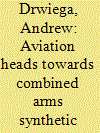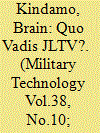|
|
|
Sort Order |
|
|
|
Items / Page
|
|
|
|
|
|
|
| Srl | Item |
| 1 |
ID:
136500


|
|
|
|
|
| Summary/Abstract |
For much of the last century, the United States led the world in technological innovation—a position it owed in part to well-designed procurement programs at the Defense Department and NASA. During the 1940s, for example, the Pentagon FUNDED the construction of the first general-purpose computer, designed initially to calculate artillery-firing tables for the U.S. Army. Two decades later, it developed the data communications network known as the ARPANET, a precursor to the Internet. Yet not since the 1980s have government contracts helped generate any major new technologies, despite large increases in funding for defense-related R & D. One major culprit was a shift to procurement efforts that benefit traditional defense contractors while shutting out start-ups.
|
|
|
|
|
|
|
|
|
|
|
|
|
|
|
|
| 2 |
ID:
136397


|
|
|
|
|
| Summary/Abstract |
The article reports on concerns of U.S. Army Aviation's leaders towards the training management due to budget cuts in army training and their focus to provide combined arms synthetic training. Topics include views of Kevin Mangum, commanding general of the U.S. Army Aviation Centre of Excellence (USAACE) on the same, improvements in Aviation Combined Arms Tactical Trainer (AVCATT) for the same and flights simulators supplied by L-3 Link Simulation and Training to U.S. Army's flight schools.
|
|
|
|
|
|
|
|
|
|
|
|
|
|
|
|
| 3 |
ID:
135202


|
|
|
|
|
| Summary/Abstract |
In late 2013, Google announced that it had acquired Boston Dynamics, an engineering and robotics company best known for creating BigDog, a four-legged robot that can accompany soldiers into rough terrain. Much of the resulting hype focused on the Internet giant and when it might start making various types of robots. What was good news for Google, however, represented a major loss for the U.S. Department of Defense. Although Google agreed to honor Boston Dynamics’ existing defense commitments, including its contracts with the U.S. Army, the U.S. Navy, and the U.S. Marine Corps, the company indicated that it might not pursue any additional work for the military. In practice, this means that the Department of Defense could lose its edge in the emerging field of autonomous robotics, which once fell almost exclusively under its domain.
|
|
|
|
|
|
|
|
|
|
|
|
|
|
|
|
| 4 |
ID:
134705


|
|
|
|
|
| Summary/Abstract |
This article provides five insights extracted from discussions concerning the Army’s long history of drawdowns. Perhaps the most important take-away is the Army can, and should, use the current drawdown constructively.
|
|
|
|
|
|
|
|
|
|
|
|
|
|
|
|
| 5 |
ID:
136008


|
|
|
|
|
| Summary/Abstract |
The CH-47 chinook has been the stalwart of global military heavy-lift operations for decades. Jamie Hunter analyses the helicopter’s service life and future upgrade programme.
|
|
|
|
|
|
|
|
|
|
|
|
|
|
|
|
| 6 |
ID:
135995


|
|
|
|
|
| Summary/Abstract |
This project examines the sophisticated cultural toolkit deployed by contemporary US military advisors to successfully build productive relationships with foreign security forces, advance the advising mission, and survive combat. This project's data stems from a three-part multi-method, including a survey conducted in Iraq; a document analysis; and interviews. This article focuses on numerous subthemes that coalesce to vividly divulge an intriguing story about how contemporary advisors build relationships with counterparts, including avoiding an “Ugly American” approach, how cross-cultural competence benefits the mission and increases survivability, learning about counterparts, the power of informal socializing, employing humor, navigating taboo topics, cultural stretching and associated limits, diplomatically balancing strength and subtlety, and taking physical and cultural risks. This project argues that effective advisors deploy a multifaceted cultural toolkit filled with peacekeeper-diplomat, warrior, subject matter expert, innovator, leader, and other tools, which reveals broader organizational changes indicative of emergent postmodern US military culture.
|
|
|
|
|
|
|
|
|
|
|
|
|
|
|
|
| 7 |
ID:
136398


|
|
|
|
|
| Summary/Abstract |
The largest –ever contract for a military pistol or handgun is finally on the brink of coming to fruition, with industry experts relishing the prospect of a specially – designed weapon system to equip the wider US armed forces.
|
|
|
|
|
|
|
|
|
|
|
|
|
|
|
|
| 8 |
ID:
137104


|
|
|
|
|
| Summary/Abstract |
As the Saigon government collapsed in 1975, the U.S. military evacuated more than 100,000 Vietnamese to the United States. Framed by congressional distrust of military action, the shift to the All-Volunteer Force, and the integration of women into the armed forces, this refugee operation marked a turning point in how the U.S. military perceived humanitarian operations. “Military” and “humanitarian” work co-existed in an uneasy balance, yet over time, operations that might be seen as routine, or even feminized, gained political value. Defining the 1975 Vietnamese evacuation as humanitarian thus became a telling precedent in the military’s growing scope of operations.
|
|
|
|
|
|
|
|
|
|
|
|
|
|
|
|
| 9 |
ID:
135585


|
|
|
|
|
| Summary/Abstract |
The article discusses the Ground-X Vehicle Technology (GXV-T) programme, launched by the U.S. Defense Advanced Research Projects Agency (DARPA) in August 2014, which invites contractors to help design a more advanced vehicle compared to the vehicles used by the U.S. Armed Forces, currently. INSETS: JLTV at a Glance;Ground-X Vehicle Technology (GXV-T) Programme.
|
|
|
|
|
|
|
|
|
|
|
|
|
|
|
|
| 10 |
ID:
136487


|
|
|
|
|
| Summary/Abstract |
The US Army currently faces challenges not unlike those of the post-Vietnam era and the post-Cold War period. Subsumed within these challenges is a more critical overarching one; simply stated, will the Army that emerges from this transition period in 2025 be an effective and ethical military profession, or just another Abstract: The US Army currently faces challenges not unlike those of the post-Vietnam era and the post-Cold War period. Subsumed within these challenges is a more critical overarching one; simply stated, will the Army that emerges from this transition period in 2025 be an effective and ethical military profession, or just another large government bureaucracy? The former can defend the Republic and its interests abroad, the latter cannot. How to understand and think about this challenge is the topic of this commentary large government bureaucracy? The former can defend the Republic and its interests abroad, the latter cannot. How to understand and think about this challenge is the topic of this commentary
|
|
|
|
|
|
|
|
|
|
|
|
|
|
|
|
| 11 |
ID:
137013


|
|
|
|
|
| Summary/Abstract |
This article traces the rise of military psychological resilience training, focusing on the US Army’s Comprehensive Soldier and Family Fitness program, which seeks to assess and instill resilience in soldiers and their families through techniques developed in the discipline of positive psychology. In maximizing the happiness, optimism, and mental fitness of soldiers, military resilience training has two aims: (1) to produce a fit fighting force capable of winning complex wars, and (2) to cut costs, not by averting war, but by ostensibly reducing the need for costly healthcare through a claim to prevent soldiers’ ‘pessimistic’ responses to war. The architects of military resilience are also exporting this model to the civilian sphere of social security, using their military experiment as ‘proof of concept’ of the scientific validity not only of resilience training, but also of positive psychology more generally. The article thus illustrates that ‘social security’ cannot be held separate from inter/national security, because these domains are, in practice, imbricated. It is argued that resilience is not merely a response to war and austerity, but a means for producing these forms of precarity through a fantasy of indomitability. The article concludes by considering the broader ethics of psychological resilience.
|
|
|
|
|
|
|
|
|
|
|
|
|
|
|
|
| 12 |
ID:
136021


|
|
|
|
|
| Summary/Abstract |
The US special operations command (USSCOMs) revolutionary tactical assault light operator suit (TALOS) effort appears to be gaining traction following the successful completion of the first practical field trails.
|
|
|
|
|
|
|
|
|
|
|
|
|
|
|
|
| 13 |
ID:
136488


|
|
|
|
|
| Summary/Abstract |
The so-called Islamic State has emerged as a major force in the struggle for the future of Syria and Iraq with a worldview that is deeply at odds with that of the United States and its allies. In this struggle, US military and intelligence personnel must analyze the nature of this organization continuously, seeking ways to overcome its
strengths and exploit its weaknesses. A discussion of such strengths and weaknesses is provided here while acknowledging constant adjustment is necessary as the Islamic State evolves.
|
|
|
|
|
|
|
|
|
|
|
|
|
|
|
|
| 14 |
ID:
135665


|
|
|
|
|
| Summary/Abstract |
The US Army’s latest future wargame explored operations within a megacity and once again highlighted the importance of empowering troops at the squad level, as well as the need to improve logistics and sustainment operations.
|
|
|
|
|
|
|
|
|
|
|
|
|
|
|
|
| 15 |
ID:
135017


|
|
|
|
|
| Summary/Abstract |
From 1945 to 1961, the United States Army Historical Division collaborated with German officers to write a history of the Second World War. As relations between the United States and the Soviet Union deteriorated and the U.S. Army prepared for a war against the U.S.S.R., the Historical Division and other parties endeavored to exploit the operational knowledge of these German officers while ignoring their attempts at mythologizing the past. This article argues, however, that a substantial intellectual baggage of racist, Social Darwinist, and generally anti-Russian beliefs underpinned even the “purely operational” German lessons that shaped U.S. Army doctrine.
|
|
|
|
|
|
|
|
|
|
|
|
|
|
|
|
| 16 |
ID:
136498


|
|
|
|
|
| Summary/Abstract |
Are we debating the right issues? Andrew Bacevich’s Breach of Trust raises questions regarding the, all Volunteer Force. Andrew Bacevich’s book, Breach of Trust: How Americans Failed Their Soldiers and Their Country, notes a stanza from the Zac Brown Band offering fried chicken, cold beer, and jeans as symbols of freedom for which soldiers fight (189). Using this piece of pop music, Bacevich concludes it once was everyone’s job to fight for our birthright – freedom. Now, a small all-volunteer force represents a country that pursues power projection through non-stop use of the military or “war,” and has lost the ethical foundation of its service along the way. I have always been repelled by the stanza, for a slightly different reason. People have died; please do not put that in the same sentiment as eating chicken. To me the stanza came to represent the well-meaning, yet rather thoughtless patriotism of many American people and the unthink- ing acceptance of it by the military. Both the act of military service, and putting it into service, demand more thought.
|
|
|
|
|
|
|
|
|
|
|
|
|
|
|
|
|
|
|
|
|